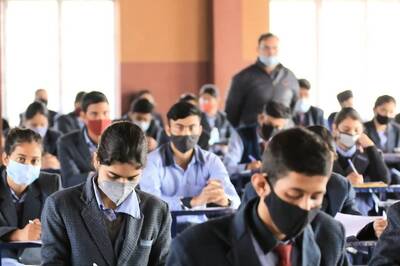
views
There is much excitement in Kashmir. The landscape at the tourist hub of Gulmarg has changed forever. An Indian Tricolour, the tallest in the Valley, has been mounted there. I am glad that conditions have been created for all to fly the Tricolour unimpeded anywhere in the Kashmir Valley. For the last two months in the run up to Independence Day, I have been receiving continuous messages regarding locations all over Kashmir where the Tricolour is proudly fluttering.
It does imply that the integration process is truly on and the design and aim of Pakistan-sponsored proxy war have been largely neutralised. Some years ago, the combined might of the nation was hesitant to risk flying the national Tricolour in many parts of Kashmir. The ability to do so today with confidence and passion exhibits positive change, which is welcome. This is a major achievement of the constitutional decisions of August 5, 2019, the second anniversary of which falls today.
Anniversaries of events are a good occasion for stock-taking. However, two years down the line, the first thought that comes to mind is the fact that almost 18 months of this period have been consumed by the coronavirus pandemic slowing down the integrative process and all other aspirational aspects arising from the historic decision. It’s a lot of work in progress but perhaps this is the right time to dispassionately review what triggered the decisions of August 5, 2019; many dots need to be joined. In my opinion, the broad underlying theme which contributed to the big decision was the rise in India’s strategic confidence.
2016 Marked the Turning Point
Way back in 2011-12, my staff at Chinar Corps made an assessment that the nature of terrorism and separatism was changing post the three-year period of street agitation (2008-10). It was evident that a struggle was ensuing between the old and the new generation; the street agitation seemed to have triggered that. It was just around the time that Burhan Wani was emerging as a young leader and the generally quieter South Kashmir seemed to be picking up pace in anti-national activities.
It was realized that Pakistan’s deep state would wish to jump on the bandwagon of this rising youth movement. On the other hand, the state administration was hell bent upon removing the Armed Forces Special Powers Act (AFSPA 1990) from some districts, an action which would put the Army on the back foot. It was our advice that given five years of unimpeded activity without AFSPA, a Pakistani bounce back was assured. This would be a blow to all the achievements of the security forces (SF). In fact, we predicted that 2016 could be considered as the inflection point when the leadership struggle could reach a boiling point, after which control would be difficult.
ALSO READ | At Kargil and LAC, A Lesson for Pakistan and China—Indian Military is No Pushover
The events from 2011-12 to 2016 may not have gone exactly as predicted but 2016 was the real turning point. Prime Minister Narendra Modi’s efforts at rapprochement in 2015 had been spurned with the ISI-sponsored Pathankot attack, seven days after his surprise visit to Lahore which was meant to transform the India-Pakistan relationship. The killing of Burhan Wani on July 8, 2016 by the Indian Army was psychologically exploited by the separatists and the deep state to bring turbulence to the streets. The chain of events commenced from there.
The Uri attack on September 18, 2016 was followed by India’s response on September 28 in the form of surgical strikes across the LoC—the first time the Indian government took ownership of trans-LoC strikes as part of proxy war. The message was appropriately limited, measured and well within the escalatory spiral. A retest with shifted focus occurred on November 29 at Nagrota. Pakistan-sponsored terrorists attempted to strike big to send home the message that India’s response could easily be absorbed by Pakistan.
The year 2017 commenced with the launch of Operation All Out in J&K by the security forces. Over the next two years, the Indian security forces neutralized over 500 terrorists even as we saw an escalation in local recruitment and attempts to fill up the Valley through infiltration. The younger leadership ruled the roost. It was realizing that without Pakistani support, its own tempo would be diluted.
The dynamic situation in 2017 continued even as India was involved in the 72-day standoff with China at Doklam which saw China stand down without a shot fired. India’s strategic confidence in dealing with its border areas received an impetus around this time. On February 14, 2019 Pakistan attempted to turn the tide of the security situation, which was improving in India’s favour, through a car bomb attack on a CRPF convoy at Pulwama which resulted in the loss of lives of at least 40 personnel. It could be considered a strategic blunder by the deep state because a response from India was inevitable; it came in the form of the Balakot airstrike.
India’s Growing Strategic Confidence
The series of events from 2016 to mid-2019 appeared to point towards increasing Indian strategic confidence. It was clear that a nexus of separatists and other anti-national elements, in the garb of over ground workers (OGWs) in Kashmir, had a degree of confidence to continue their activities. One of the enablers was the special status accorded to Kashmir under Articles 370 and 35A which somehow kept the state of J&K away from the line of integration. That identity also helped promote separatism and was a sentiment which was exploited by external players. Socially, the integrative process within the state was also lagging as many segments remained disempowered, thus giving rise to discord.
ALSO READ | Jammu Twin Blasts Show It’s Time to Clearly Think Through the Right Offensive Options
Reflecting back, Article 370 should have been abrogated in 1972 with the signing of the Simla Agreement. India was perhaps shy of its own military victory and could have lacked the strategic confidence to handle the fallout. In February 1994 when India was under intense pressure from a US-led move to castigate New Delhi over human rights record, it responded with the Joint Resolution of both Houses of Parliament declaring all territories of the erstwhile princely state of J&K as belonging to India.
This was also an occasion when India could have done away with Articles 370 and 35A as political consensus existed; what was lacking was strategic confidence. Twenty five years later the decision could finally be taken although little political consensus existed. What ensured the decision was the perceptible success in handling events through 2016-19 and the strong political authority which existed at the Centre. That is what strategic confidence is all about.
Coincidentally, it is the same strategic confidence which also worries China but equally has given the US the perception that India would be a suitable strategic partner. Such situations perhaps come in the history of most nations which have larger goals and aspirations. Stabilising J&K through new policies, empowering more people and ensuring uniformity of laws for all citizens will indeed be the counter against all trends of separatism and a model for all. August 5, 2019 was indeed a red-letter day for J&K.
The writer is a former GOC of the Srinagar based 15 Corps and Chancellor Central University of Kashmir. The views expressed in this article are those of the author and do not represent the stand of this publication.
Read all the Latest News, Breaking News and Coronavirus News here.
















Comments
0 comment